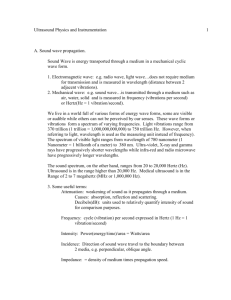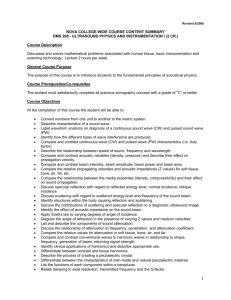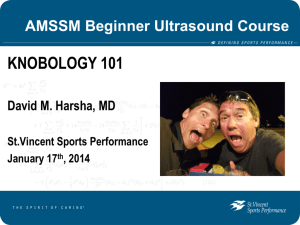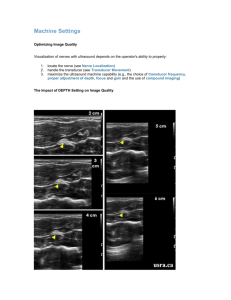Physics of Ultrasound
advertisement
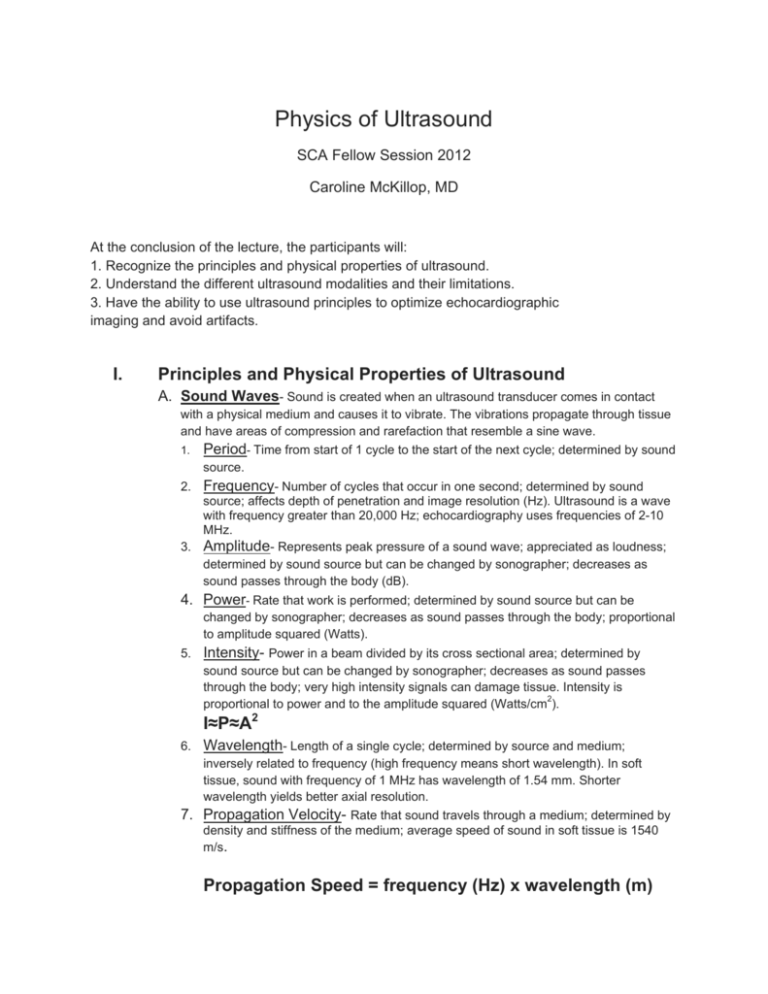
Physics of Ultrasound SCA Fellow Session 2012 Caroline McKillop, MD At the conclusion of the lecture, the participants will: 1. Recognize the principles and physical properties of ultrasound. 2. Understand the different ultrasound modalities and their limitations. 3. Have the ability to use ultrasound principles to optimize echocardiographic imaging and avoid artifacts. I. Principles and Physical Properties of Ultrasound A. Sound Waves- Sound is created when an ultrasound transducer comes in contact with a physical medium and causes it to vibrate. The vibrations propagate through tissue and have areas of compression and rarefaction that resemble a sine wave. 1. Period- Time from start of 1 cycle to the start of the next cycle; determined by sound source. 2. Frequency- Number of cycles that occur in one second; determined by sound source; affects depth of penetration and image resolution (Hz). Ultrasound is a wave with frequency greater than 20,000 Hz; echocardiography uses frequencies of 2-10 MHz. 3. Amplitude- Represents peak pressure of a sound wave; appreciated as loudness; determined by sound source but can be changed by sonographer; decreases as sound passes through the body (dB). 4. Power- Rate that work is performed; determined by sound source but can be changed by sonographer; decreases as sound passes through the body; proportional to amplitude squared (Watts). 5. Intensity- Power in a beam divided by its cross sectional area; determined by sound source but can be changed by sonographer; decreases as sound passes through the body; very high intensity signals can damage tissue. Intensity is proportional to power and to the amplitude squared (Watts/cm2). I≈P≈A2 6. Wavelength- Length of a single cycle; determined by source and medium; inversely related to frequency (high frequency means short wavelength). In soft tissue, sound with frequency of 1 MHz has wavelength of 1.54 mm. Shorter wavelength yields better axial resolution. 7. Propagation Velocity- Rate that sound travels through a medium; determined by density and stiffness of the medium; average speed of sound in soft tissue is 1540 m/s. Propagation Speed = frequency (Hz) x wavelength (m) B. Interaction between Sound and Tissue- An ultrasound transducer emits sound waves which continue traveling until they reach a junction of two tissues with different acoustic properties. At this point, the energy is either reflected back towards the transducer or transmitted into the next tissue, but not necessarily in the same direction as it started. 1. Reflection- The percentage of ultrasound energy reflected back to the transducer depends on the difference in the acoustic impedances (Z) of the two tissues that are interfacing. The larger the difference in acoustic impedance between the two media, the greater percentage of ultrasound energy is reflected back to the transducer. Z = density x propagation velocity of sound in a medium (1540 m/s in soft tissue) 2. Refraction- The percentage of ultrasound energy that is not reflected continues traveling through tissue but is said to be refracted, as its direction has been changed by the interaction between the two tissues. Sound waves undergo the most refraction when there is an acute angle of incidence and a large difference in velocities of sound waves in the two interfacing tissues. An angle of incidence of 900 can eliminate refraction, optimize reflection, and prevent creation of artifacts. Therefore for optimal TEE imaging, the object of interest should be perpendicular to the ultrasound beam. 3. Attenuation- As sound travels through tissue, it continually loses energy. The result of this dispersion and absorption of the sound waves is that the farther a structure is from the transducer, the weaker the returning echoes. Using a lower frequency transducer and utilizing time-gain compensation are both mechanisms for minimizing attenuation and therefore optimizing the image. C. Transducers1. Components● Piezoelectric crystal- Acts as both an ultrasonic vibrator and a receiver of echoes. Can transform electrical energy into mechanical energy and vice versa. ● Electrodes- Conduct energy to stimulate the crystal and record the voltage from returning echoes. ●Backing- Dampens the crystal’s vibrations quickly in order to shorten pulse duration and spatial pulse length. ●Insulation- Prevents extraneous waves from interfering with the image creation. ●Matching Layer- Has acoustic impedance between that of the transducer and the esophagus and therefore functions to reduce reflection where the transducer and tissue meet. Less reflection means that more energy is transmitted through the esophagus and to the heart. 2. Ultrasound Beam- Transducers emit a 3D ultrasound beam that has two zones: the near field (Fresnel zone) and far field (Franhofer zone). The near zone offers better resolution, better beam manipulation, stronger echoes, and higher image quality. Narrower beams are optimal because they offer improved resolution, higher intensity returning echoes and less artifact. The best way to achieve an optimal image is with a long, narrow near field and a less divergent far field. This goal is best accomplished with a large transducer with high frequency signals. Near Field Length = (Transducer Diameter)2/(4 x wavelength) 3. Focus- Focusing the ultrasound further narrows the beam and improves the image in the near zone. Focusing is accomplished by achieving a concave shape for the piezoelectric crystal, placing an acoustic lens on the front of the crystal, and using a phased array transducer (beam front diverges in a hemispheric pattern). The advantage to focusing is an improved image in the near zone, but this must be balanced with the disadvantage of a poorer image in the far field. 4. Resolution- The ability to distinguish between two points in space. Lengthening the near field via a high frequency transducer and a large transducer radius will improve lateral and elevational resolution (and therefore yield a better image in the near field). Resolution Type Definition How to Optimize Lateral Resolution Ability to resolve 2 adjacent structures that are perpendicular to beam axis. Ability to detect single small objects across the width of the beam. Minimum distance where one can resolve 2 structures oriented parallel to beam axis. Avoid excess power or gain; use focused transducer with high frequency and large aperture diameter. Optimal at 1 near zone length (focal depth) because beam is narrowest here. Ability to display more images per second. Directly related to frame rate. Minimize depth, minimize sector size (less pulses and higher frame rate), decrease line density, and use high frequency transducer. Ability to resolve two objects that lie vertical to the beam. Better with a narrower US beam; based on signal frequency and transducer size. (angular, transverse, azimuthal, LATA, depth/50, smaller # is better quality) Axial Resolution (longitudinal, LARRD, SPL/2, wavelength * 1.5, smaller # is better quality) Temporal Resolution (May have decrease in image quality as temporal resolution increases) Elevational Resolution (Depth/30) II. Shorten pulse duration by using high frequency transducers with wide frequency bandwidths and appropriate damping. Short pulses of high frequency US are best for axial resolution. Ultrasound Modalities A. One-Dimensional (1D)- 1D modes allow determination of the amplitude of the returning ultrasound signal and the distance between the transducer and the reflective surface. Because the speed of sound in soft tissue is relatively constant (1540 m/s), the machine uses the round trip travel time of the echo to determine the location of the structure of interest. 1. A-Mode (Amplitude)- Amplitudes of returning echoes are displayed as horizontal spikes along a vertical axis. Spike height corresponds to the distance from the structure and the amplitude of the returning signal. A-Mode was the original display format. 2. B-Mode (Brightness)- Amplitudes of returning echoes are displayed as pixels along a vertical axis. The brightness of each pixel is based on the strength of the returning signal. Current imaging is based on B-Mode. 3. M-Mode (Motion)- M-Mode adds temporal information to B-Mode imaging and shows a 1D, “icepick” view through the heart. M-Mode has a very high frame rate and therefore excellent temporal resolution, but it offers only limited views of cardiac anatomy. It is best used for analyzing the timing of cardiac events. B. Two-Dimensional (2D)- 2D echo is a modification of B-Mode that allows display of shape and lateral motion. The transducer sequentially fires ultrasound pulses across a sector of the heart, as opposed to the one directional firing seen in 1D ultrasound. 1. Scan Systems- 2D ultrasound uses a phased array transducer that combines individual sound waves into a unified front that can be easily focused and steered electronically without actually moving the transducer. The phased array sector scanner is the most common type used in echocardiography. This scanner is able to time the activation of the individual piezoelectric crystals in order to send the sound beam out in an arc and achieve a focused image. 2. Image● Frame- Each image created by a sector scan; usually 100-200 scan lines per frame. ● Frame rate- Speed at which sector is scanned; usually 30-60 frames/second; depends on sector depth (time to scan) and width (number of scan lines). Higher frame rate gives better temporal resolution. ● Pulse repetition frequency (PRF)- Rate at which sound pulses are transmitted per second; higher PRF means more scan lines per period of time; inversely related to sector depth. ● Scan line density- Number of scan lines per degree of the sector. Higher scan line density improves image quality via improved lateral resolution. The disadvantage to a high scan line density is a decrease in frame rate and therefore a decrease in temporal resolution. **The best images are obtained by balancing frame rate (speed) and scan line density (image size). This is achieved by focusing on one structure at a time and putting that structure in the near field. Focusing and minimizing depth allows a higher scan line density while still maintaining an adequate frame rate to assess motion. If a maximal frame rate is required, M-Mode should be used. C. Three-Dimensional (3D)- 3D echo is possible due to the creation of fully sampled matrix-array transducers. These transducers have thousands of piezoelectric elements that are arranged in a matrix configuration and are connected via several small circuit boards within the transducer. The elements are able to simultaneously acquire data and create a pyramidal sector. In order to acquire 3D data one must choose between real-time (live) 3D echo and electrocardiographically triggered multiple-beat 3D echo. Live 3D echo offers the advantage of multiple data sets from one heartbeat (especially helpful in patients with arrhythmias) but is limited by its poor temporal and spatial resolution. Multiple-beat 3D echo acquires data over 2-7 cardiac cycles and stitches together the images into one data set. The disadvantage to multiple-beat echo is the inherent risk of artifact from arrhythmias or patient movement, as this method requires more time to acquire data. Gain settings are very important in 3D echo, as excess gain inhibits 3D depth perception and inadequate gain causes drop-out of important anatomic structures. It is thus recommended that both gain and compression settings should be in the midrange. In addition, slightly more time gain compensation than usual is helpful for avoiding undergain/drop-out and also allows more post-processing options. D. Doppler- While 2D echo is excellent for imaging cardiac anatomy, it is limited in its assessment of blood flow. Doppler ultrasonography is an excellent tool that allows the sonographer to delineate velocity, direction, and magnitude of blood flow. 1. Doppler Effect- Doppler systems are able to determine the velocity of blood flow by “listening” for the change in frequency that is reflected back from returning red blood cells. The Doppler effect refers to the fact that returning red blood cells have a different pitch than outward traveling red blood cells. Sound waves are compressed in the direction of a motion and compressed in the opposite direction. Thus, blood returning to the transducer is compressed and has a higher frequency and longer wavelength than the blood traveling away from the transducer. ●The Doppler Equation: ∆f = v x cosθ x 2ft/c ∆f- change in frequency between transmitted and received signals v- velocity of the blood cells θ- angle of incidence between blood flow and the ultrasound beam ft- frequency of transmitted signal c- speed of sound in blood (1540 m/s) To most accurately account for red blood cell velocity, the transducer should be as parallel to blood flow as possible. The sonographer’s goal should be an angle of incidence (θ) of 30o or less. Because cos 0 = 1 and cos 1=0, the closer to 0o the angle of incidence, the less one will underestimate blood velocity. 2. Pulsed Wave Doppler (PWD)- Pulsed wave doppler uses one crystal to send and receive ultrasound waves. Because the speed of sound in soft tissue is constant (1540 m/s), the system can determine the distance from the transducer to the target based on the amount of time it takes for the signal to travel to the target and then return to the transducer. PWD is time gated, because the sonographer must select a specific depth/location to evaluate. The blood at this location is called the sample volume. Because PWD uses only one crystal, this single crystal sends out a series of ultrasound bursts and then stops and listens for the returning echoes. The rate at which it generates these sound bursts is called the pulse repetition frequency (PRF). Limitations of PWD: PWD has a Nyquist limit, which is the maximal frequency and blood velocity that can accurately be measured due to the fact that there is only one crystal intermittently collecting data. The Nyquist limit is ½ PRF. At Doppler shifts above the Nyquist limit, aliasing or wraparound is said to occur and one cannot accurately interpret the data. Using a low transmitted frequency will allow higher velocities and greater sample depths to be measured with less attenuation. Regardless, PWD is generally limited to velocities less than 1.4m/s. 3. Continuous Wave Doppler (CWD)- Continuous wave doppler uses two crystals- one to continuously transmit the signal and one to continuously “listen” for the return. Thus CWD is not limited by a maximal velocity (Nyquist limit) and can measure very high velocity blood flow. In addition, CWD measures velocities all along the path of the beam and is not time gated as PWD is. The final difference in PWD and CWD lies in the spectral display. PWD has a clean, unshaded envelope, while CWD has a shaded envelope representing the multiple velocities measured along the path of the beam. 4. Color Flow Doppler- Color flow doppler uses a combination of PWD and 2D ultrasound to simultaneously display both cardiac anatomy and blood flow. Multiple sample volumes along each scan line are assessed, and the data is color-coded and superimposed on top of the gray 2D image. While different color scales are used, the most frequently used scale uses red to indicate flow toward the transducer and blue to indicate flow away from the transducer; turbulent flow is generally depicted by a green color; and black indicates no Doppler shift at all. It is important to note that because color flow doppler uses PWD technology, it is subject to aliasing. III. Artifacts and Image Optimization A. Artifacts- Understanding of proper ultrasound settings and knowledge of the possible artifacts that can occur allows the echocardiographer to optimize image quality and avoid many diagnostic errors. 1. Side and grating lobes- Side lobes can occur when an ultrasound beam goes off of the main beam path and encounters a very echo-dense structure such as a calcified valve or a prosthetic structure like a catheter. The reflections from these structures are included in the final image but are misplaced because they originated from an extraneous, side beam. Grating lobes are side lobes that are created with multielement array transducers. Sound waves meet in constructive interference off axis to the main beam and place an extraneous structure within the original 2D image. 2. Acoustic shadowing- When an ultrasound beam encounters a junction of two structures with very different acoustic impedances, shadowing can occur beyond the strong reflector (structure with high acoustic impedance). The most common example occurs when there is a lack of signal beyond a highly calcified or prosthetic valve. 3. Reverberation- Reverberation can occur when an ultrasound beam is repeatedly reflected back and forth between two very strong reflectors. The result is a duplication of the structure in the far field and is often described as appearing as a ladder or comet tail. A frequent offender of reverberation artifact is the descending thoracic aorta, which is seen correctly in the near field but falsely reappears in the far field. 4. Mirror Imaging- In addition to the normal returning signals from a strong reflector, some extraneous weak signals can travel in a different direction and appear as a duplicate or mirror image of the original. This artifact is more often seen with excessive gain settings. B. Processing- Processing of the ultrasound signal occurs once the returning beam is received by the transducer and converted back into an electrical signal by the piezoelectric crystal. 1. Amplification/Gain Control- As an ultrasound signal travels through tissue and returns to the transducer, it loses energy. The returning echo is attenuated, particularly if a structure is far from the transducer. The system gain control amplifies the attenuated returning signal so that it can be processed into the final image. The echocardiographer can compensate for the attenuation of distant structures by selectively amplifying these signals using the time gain compensation controls. 2. Preprocessing- Preprocessing occurs prior to image storage and cannot usually be performed on still images. It includes filtering out “noise,” demodulating the signal (converting the echo from radio frequency to video form), and differentiating the signal so there is edge enhancement. In addition, dynamic range manipulation affects the various shades of gray that are seen in the image. By increasing the compression, the echocardiographer can have a higher contrast image (more black and white than shades of gray). By decreasing the compression, the image will have more shades of gray. 3. Postprocessing- Postprocessing allows conversion to analog video form. Unlike preprocessing, postprocessing can be performed on still images because it affects the data after it is retrieved from the machine memory. It involves the way in which the formatted information is displayed on the monitor and includes such options as gray-scale mapping, black and white inversion, read zoom, and B color (allows colors other than gray to be used in order to distinguish subtle anatomic details). Postprocessing only affects the displayed image, not the stored image. References Edelman SK. Ultrasound Physics and Instrumentation. Woodlands, TX: ESP, Inc., 2002. Lang RM, et al. “EAE/ASE Recommendations for Image Acquisition and Display Using Three-Dimensional Echocardiography.” Journal of the American Society of Echocardiography. 2012;25:3-46. Perrino AC, Reeves ST, eds. A Practical Approach to Transesophageal Echocardiography, 2nd Ed. Philadelphia: Lippincott Williams & Wilkins, 2008. Savage RM, Aronson S, et al eds. Comprehensive Textbook of Intraoperative Transesophageal Echocardiography. Philadelphia: Lippincott Williams & Wilkins, 2005.


